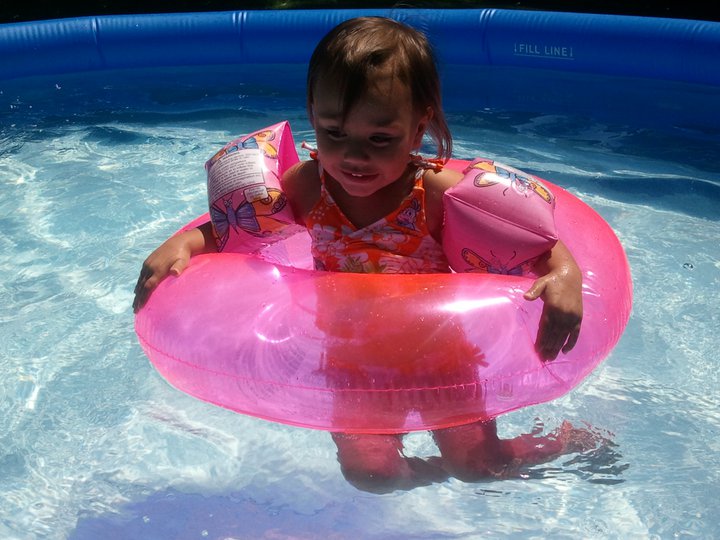Keeping Your Child Safe- Water Safety Tips
 Summer is approaching us and with summer comes trips to the beach, swimming in back yard pools, boating, or maybe some fishing in a pond or lake! When the weather turns warm, everyone wants to be in or around water. Hanging out at the pool or the beach is a great way to beat the summer heat!
Summer is approaching us and with summer comes trips to the beach, swimming in back yard pools, boating, or maybe some fishing in a pond or lake! When the weather turns warm, everyone wants to be in or around water. Hanging out at the pool or the beach is a great way to beat the summer heat!
When I think about these activities, I immediately think of protecting my kids in and around water with sunscreen. I grab a bottle with the highest SPF I can find and cover their little bodies head to toe. Sunscreen is a great start to protecting your child on a day at the beach or pool, but what about their safety while in the water? The water is so much fun for kids but it can also be very dangerous without the proper precautions taken.
The Statistics:
According to International Life Saving Federation – Drowning Facts & Figures 1.2 million people around the world die by drowning every year. That is more than two persons per minute. From that more than 50 percent are children. There are eight to ten times that many who experience near drowning but who reach safety alone or are rescued by their peers or lifeguards. For people between the ages of 5 and 24, drowning is the second leading cause of accidental death.
- About one third of children who drown do so in and around the home.
- Infants and toddlers drown more frequently than people at any other age. In this age group drowning is the leading cause of death. The backyard swimming pool is the riskiest site for this group.
- Four out of every ten drownings happen within two meters of shore or the pool side and one-quarter happen in shallow water one meter deep or less.
- Approximately 3,000 people world wide become partially or completely paralyzed each year as a result of breaking their necks. Most of these injuries occur while diving into shallow water.
Most water related accidents can be avoided though by following a few simple guidelines. The first step is to learn how to swim. There are several local organizations like the YMCA that offer swimming instruction.
- Always stay within arms reach of your child when he or she is in or near pools or bathtubs.
- Never leave your child unattended near water even if they know how to swim
- Never leave a child alone while in the bathtub, even for just a few minutes
- Learn infant and child CPR in case of a water emergency
Pool Safety:
- Have a fence that is at least 4 feet high around the pool with a self-latching locked gate
- Pool alarms are a great way to know if a child has fallen into the pool
- Cover and lock your pool when it is not in use
- When pool is not in use, remove the ladder
- Always watch children while they are swimming in a pool
- Children who cannot swim well should be within arms reach at all times and wear a life jacket
- Never dive into shallow water
- If your child is missing, check the water first
- Children who cannot swim should wear US Coast Guard approved life jackets and everyone should wear a life jacket when participating in water-sport activities such as water skiing.
- Life jackets should be appropriate size for the child's age and fit properly
- Know Your Flotation Devices from BoatingSidekicks.com gives great information about the different types of flotation devices and how to properly use them
- Make sure you have proper flotation devices on the boat at all times
- Keep a close eye on the weather, waves, and currents
- Get out of the water immediately if you hear thunder or see lightning!
- Teach children that swimming in currents is not the same as swimming in pools
- Take a Boaters Safety Course offered in many areas
- Never operate a boat while under the influence of alcohol
 Protection From The Sun's Rays:
Protection From The Sun's Rays:
- Always choose a water-proof sunscreen
- Your child's sunscreen should be at least SPF 30 according to Skin Care Foundation
- Reapply every couple of hours especially if in and out of the water. Even water-proof sunscreen will eventually wash off in the water or when drying off with a towel.
- When out in the sun for extended periods of time, especially in water, take frequent breaks out of the sun.
- Drink plenty of fluids to avoid dehydration and heat exhaustion.
Summer is a fun time of the year but without following these safety precautions it can be tragic. Teach your child to swim and always closely supervise them in or near water. Boating laws vary from state to state, so contact your local boating enforcement agency for more information or to take a boaters safety course. Safety in the water, especially with young children should be taken very seriously.
What are some of your favorite summer time water activities and what steps do you take to ensure your child's safety? We would love to hear from you!





I remeber as a kid being pushed into the deep end of a pool by my grandmother. She insisted that in her day that is how kids learned to swim; sink or swim. I never got the chance to push her in, but I wouldn't have anyway because she couldn't swim, which incidentally makes her a bit of a hypocrite.
Thank you for sharing such helpful content!